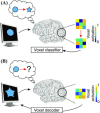A network engineering perspective on probing and perturbing cognition with neurofeedback
- PMID: 28445589
- PMCID: PMC5446287
- DOI: 10.1111/nyas.13338
A network engineering perspective on probing and perturbing cognition with neurofeedback
Abstract
Network science and engineering provide a flexible and generalizable tool set to describe and manipulate complex systems characterized by heterogeneous interaction patterns among component parts. While classically applied to social systems, these tools have recently proven to be particularly useful in the study of the brain. In this review, we describe the nascent use of these tools to understand human cognition, and we discuss their utility in informing the meaningful and predictable perturbation of cognition in combination with the emerging capabilities of neurofeedback. To blend these disparate strands of research, we build on emerging conceptualizations of how the brain functions (as a complex network) and how we can develop and target interventions or modulations (as a form of network control). We close with an outline of current frontiers that bridge neurofeedback, connectomics, and network control theory to better understand human cognition.
Keywords: cognition; control theory; graph theory; network neuroscience; neurofeedback.
© 2017 The Authors. Annals of the New York Academy of Sciences published by Wiley Periodicals Inc. on behalf of The New York Academy of Sciences.
Figures





References
-
- DiLorenzo D.J. & Bronzino J.D., Eds. 2007. Neuroengineering. CRC Press.
-
- Buettner, H.M. 1995. Neuroengineering in biological and biosynthetic systems. Curr. Opin. Biotechnol. 6: 225–229. - PubMed
-
- Jeong, J.W. et al 2015. Soft materials in neuroengineering for hard problems in neuroscience. Neuron 86: 175–186. - PubMed
-
- Moxon, K.A. & Foffani G.. 2015. Brain–machine interfaces beyond neuroprosthetics. Neuron 86: 55–67. - PubMed
Publication types
MeSH terms
Grants and funding
LinkOut - more resources
Full Text Sources
Other Literature Sources

